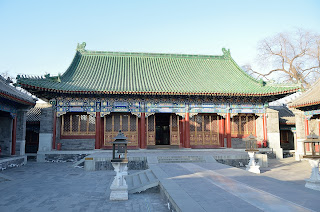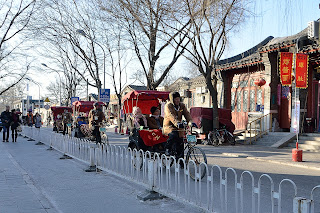These pictures are a couple weeks old - from right after New Years Day. Margot and I visited what is known as Prince Gong's Mansion or sometimes Prince Kung's Mansion.
It was built in 1777 for a court official named Heshen. It is built in the classic Chinese style with courtyards with buildings on all four sides.
In a lesson about transient nature of power, the succeeding emperor accused Heshen of corruption and confiscated his property.
The property passed on to the emperor's son and then eventually was given to his successors son named Prince Gong.
After the fall of the Chinese imperial system, Prince Gong's grandson assigned the deed to the Catholic Church.
The Catholic Church spent a lot of money to fix it up and then used it as a university until they were kicked out of China in 1951.
According to Wikipedia, the complex was used as as an air conditioning factory during the Cultural Revolution (1966-1976).
Wikipedia Entry
The Chinese government declared it a national level heritage asset and fixed it up and now it is a popular tourist attraction.
The captions of these pictures are all in Chinese but it appears they show some of the Prince's travels and court officials.
It is worth a visit although it could benefit from some more English description for the foreign visitors.
This is a room in one of the halls.
This shrine is at the back of the complex. If you click on the picture you can see it a little better. Again, those are prayer requests on the red tablets.
The gate behind temple leads to a large garden.
Here is a view of the park/garden.
This picture is on the street outside the attraction. Margot thought the dog was cute with a couple of layers of cold weather gear.
Click for a better view.
Prince Gong's Mansion is in an interesting tourist area with hutongs, lakes, etc. You can take a tour on these pedicabs through the hutongs.
I took this out of the door way of the subway on our way back. This is subway line 6 which had just opened a few days earlier. It isn't 100% finished but it is quite modern. It has interesting decorations that mirror the neighborhood on the streets above.


















































